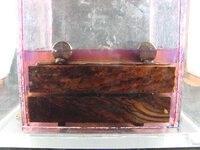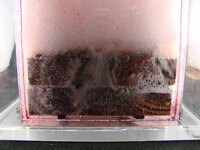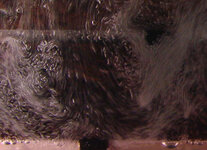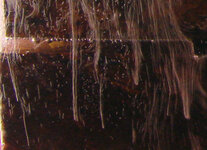MesquiteMan
Retired Head Moderator
I see this question frequently..."Is 25" Hg enough vacuum for good stabilizing?". I always answer that it will work fair but will not give optimal results and best penetration. To prove this point, I decided to take some pictures during a recent stabilizing cycle.
These pics are taken using an acrylic stabilizing chamber and Cactus Juice. The juice is a little pink because I forgot to clean off my weight from the red I did right before this. It is normally clear!
This was taken in Central Texas at an elevation of about 940' above sea level. Remember, the maximum theoretical vacuum is 29.92" Hg at sea level and you loose 1" Hg for every 1,000' above sea level. Here, my maximum theoretical vacuum is around 28,92" give or take. In other words, if you are at 4,000' above sea level, your maximum theoretical vacuum is 25.92" Hg so 25" is a really good vacuum. I know, it is confusing!
Anyway, here is a set of black walnut blanks that are vacuumed down to 25" Hg by controlling the amount of vacuum through a vacuum bleed system on my chamber. I held it at 25" until the bubbles stopped.

Here is the same set of blanks with the vacuum increased to 27" Hg.

And finally, the same set of blanks at 28.5" Hg, close to my theoretical maximum vacuum at my elevation above sea level.

So, as you can see, the more vacuum you can generate, the more the air is removed from the blanks. The more air you remove, the more the resin can penetrate and saturate the wood. So, in my opinion and from experience, 25" Hg when your elevation allows a higher vacuum is not going to give you the best results.
Hope the pics helped visualize this better for some!
These pics are taken using an acrylic stabilizing chamber and Cactus Juice. The juice is a little pink because I forgot to clean off my weight from the red I did right before this. It is normally clear!
This was taken in Central Texas at an elevation of about 940' above sea level. Remember, the maximum theoretical vacuum is 29.92" Hg at sea level and you loose 1" Hg for every 1,000' above sea level. Here, my maximum theoretical vacuum is around 28,92" give or take. In other words, if you are at 4,000' above sea level, your maximum theoretical vacuum is 25.92" Hg so 25" is a really good vacuum. I know, it is confusing!
Anyway, here is a set of black walnut blanks that are vacuumed down to 25" Hg by controlling the amount of vacuum through a vacuum bleed system on my chamber. I held it at 25" until the bubbles stopped.
Here is the same set of blanks with the vacuum increased to 27" Hg.
And finally, the same set of blanks at 28.5" Hg, close to my theoretical maximum vacuum at my elevation above sea level.
So, as you can see, the more vacuum you can generate, the more the air is removed from the blanks. The more air you remove, the more the resin can penetrate and saturate the wood. So, in my opinion and from experience, 25" Hg when your elevation allows a higher vacuum is not going to give you the best results.
Hope the pics helped visualize this better for some!
Attachments
Last edited:





